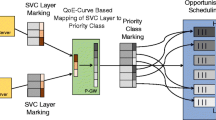Abstract
In order to improve the access efficiency of multimedia communication system and solve the problem of two-way link collaboration effectively, based on the collaboration between uplink and downlink, an adaptive multimedia streaming segmentation access mechanism is proposed. First, the multimedia communication system is divided into the transmitter division module, the receiver modular module and the relay network joint control module. In the sending end, the segmentation and flow mapping of multimedia streams are implemented. At the receiving end, the flow control of the multimedia sub-stream and the reorganization of the split flow are realized. The relay network realizes the area division and error detection of the channel capacity. Secondly, the downlink of the multimedia communication system is divided into the parallel multimedia data stream of the server cluster and multiple concurrent users. After interweaving the downlink and the uplink of the multimedia stream segmentation, the cooperative parallel multimedia stream is formed. At the same time, the interleaving weight of the downlink and the weightings of the uplink are combined in order to coordinate the area division and Realization of the channel capacity of the duplex link. Finally, simulation experiments verify the feasibility and effectiveness of the proposed algorithm in terms of resource utilization, wireless access accuracy and efficiency, and multimedia communication quality.








Similar content being viewed by others
References
Aswale S, Ghorpade VR (2017) LQEAR: link quality and energy-aware routing for wireless multimedia sensor networks[J]. Wirel Pers Commun (4):1–14
Batalla JM (2016) Advanced multimedia service provisioning based on efficient interoperability of adaptive streaming protocol and high efficient video coding[J]. J Real-Time Image Proc 12(2):443–454
Bhatt C, Popescu-Belis A, Cooper M. (2016) Audiovisual summarization of lectures and meetings using a segment similarity graph[C]//. ACM Int Conf Multimed Retriev. ACM: 261–264
Chen Y, Xiao J, Zhan G, et al. (2018) Two-level segment-based bitrate control for live ABR streaming[C]// international conference on multimedia modeling. Springer, Cham::556–564
Choi M, Lee G, Jin S et al (2016) Link adaptation for high-quality uncompressed video streaming in 60-GHz wireless networks[J]. IEEE Trans Multimed 18(4):627–642
Chu L, Zhang Y, Li G et al (2016) Effective multimodality fusion framework for cross-media topic detection[J]. IEEE Trans Circ Syst Video Technol 26(3):556–569
Giangreco I, Adam SH (2016) Pro, : database support for big multimedia retrieval[J]. Datenbank-Spektrum 16(1):17–26
Jiang D, Shi L, Zhang P et al (2016) QoS constraints-based energy-efficient model in cloud computing networks for multimedia clinical issues[J]. Multimed Tools Appl 75(22):14307–14328
Jin A, Song W, Wang P et al (2016) Auction mechanisms toward efficient resource sharing for cloudlets in mobile cloud computing[J]. IEEE Trans Serv Comput 9(6):895–909
Kim HS, Lee DS (2017) Influence of monitoring data selection for optimization of a steady state multimedia model on the magnitude and nature of the model prediction bias.[J]. Chemosphere 186:716
Kotevsk Z, Tasevska I (2017) Evaluating the potentials of educational systems to advance implementing multimedia technologies[J]. Int J Modern Edu Comput Sci 9(1):26–35
Li J, Zhou T, Lu Y (2017) Learning to generate video object segment proposals[C]// IEEE international conference on multimedia and expo. IEEE Comput Soc: 787–792
Lin C, Pun CM, Huang G (2016) Highly non-rigid video object tracking using segment-based object candidates[J]. Multimed Tools Appl 76(7):1–22
Patrona F, Iosifidis A, Tefas A et al (2016) Visual voice activity detection in the wild[J]. IEEE Trans Multimed 18(6):967–977
Seema A, Shah T, Schwoebel L et al. (2018) Power profiling of multimedia sensor node with name-based segment streaming[J]. Multimed Tools Appl (5):1–27
Shujuan Wang, Long He, and Guiru Cheng, (2015) Cooperative optimization QoS cloud routing protocol based on bacterial opportunistic foraging and chemotaxis perception for mobile internet. J Elect Comput Eng 2015, article ID 641062, 7 pages. doi:https://doi.org/10.1155/2015/641062
Ye C, Gursoy MC, Velipasalar S (2016) Multimedia transmission over device-to-device wireless links[C]// IEEE international conference on multimedia and expo. IEEE:1–6
Acknowledgements
1. Construction and application of carbon information disclosure quality evaluation index system of national statistical science research project of National Bureau of Statistics of PRC(2017LY36).
2. Research on the development of Hunan carbon financial market mechanism of Hunan Social Science Achievements Appraisal Committee Project (XSP18YBC348).
Author information
Authors and Affiliations
Corresponding author
Additional information
Publisher’s Note
Springer Nature remains neutral with regard to jurisdictional claims in published maps and institutional affiliations.
Rights and permissions
About this article
Cite this article
Zhang, Q., Xu, D. Multimedia flow segmentation access mechanism with adaptive cooperative uplink and downlink. Multimed Tools Appl 78, 8723–8735 (2019). https://doi.org/10.1007/s11042-018-6238-4
Received:
Revised:
Accepted:
Published:
Issue Date:
DOI: https://doi.org/10.1007/s11042-018-6238-4




